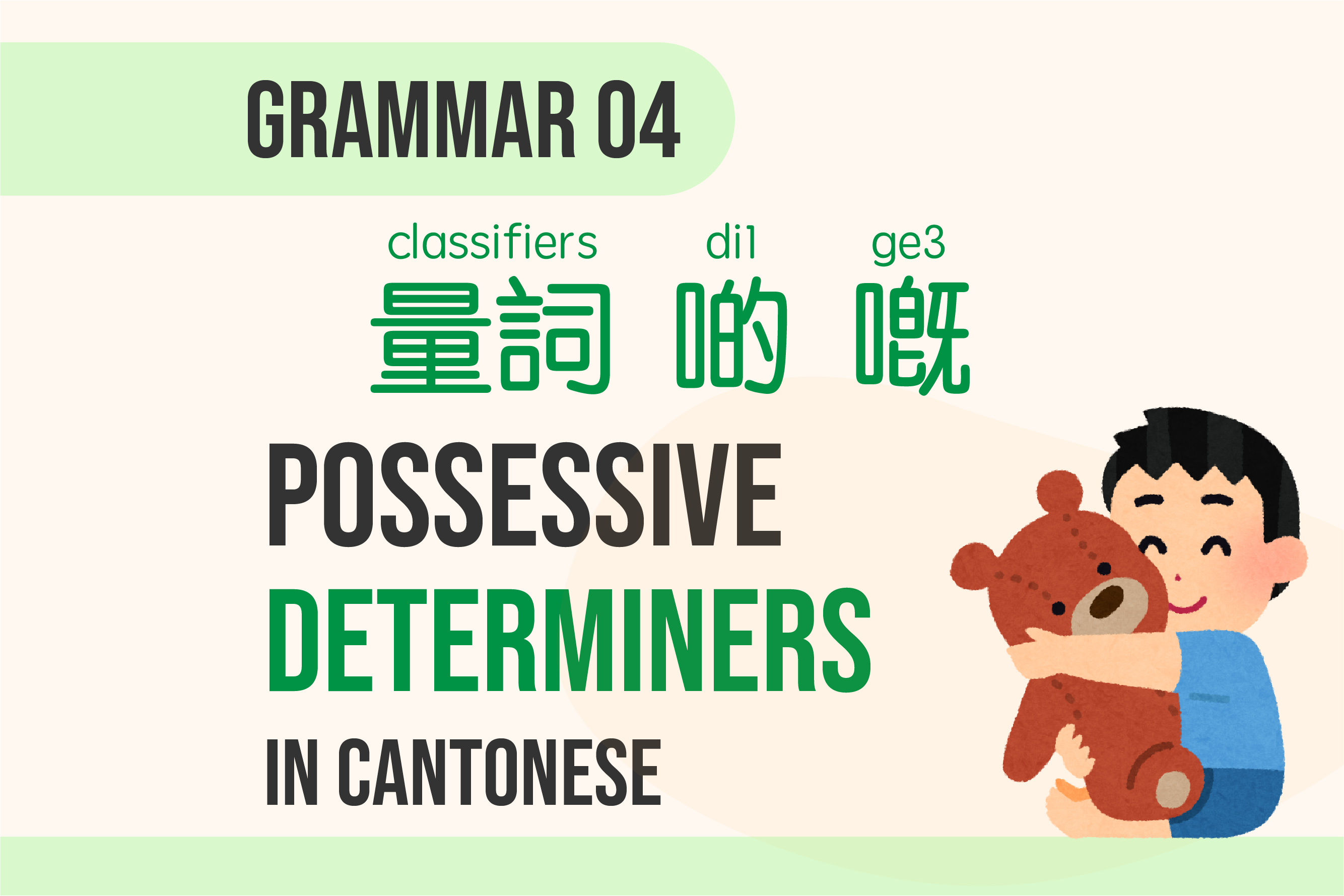Table of Content
When discussing possessive determiners in English, such as 'my,' 'your,' 'his,' 'her,' 'its,' 'their,' or 'someone’s,' which are followed by a noun, there are 3 common patterns used in Cantonese. For all patterns mentioned below, personal pronouns can be replaced with specific names like 'Peter' or with any nouns that can indicate possession (nouns to which you can add 's in English).
Pattern A - Personal Pronouns-Classifier-Noun
This pattern, similar to that of demonstrative determiners, usually applies to concrete, non-abstract nouns and can be used for both singular and plural forms (only for plural nouns that are in a status that matches the classifiers).
It's important to note that the usage of this pattern in possessive determiners is almost exclusively found in Cantonese. Modern written Chinese and Mandarin usually replace the classifier with "的" when indicating possession.
【Personal Pronouns - Classifier - Noun】
Singular Concrete Nouns
我部電腦好重
My computer/laptop is heavy.
部 - classifier for vehicles or machine你對鞋好靚
Your shoes are beautiful.
對 - pair
Although 'shoes' is plural in English, we usually treat them as a single pair (對). Using '啲' would imply multiple pairs of shoes.佢枝/支筆好平.
His/Her pen is cheap.
枝/支 - classifier for long and thin objects我哋間屋好亂
Our house is messy.
間 - classifier for a portion of or an entire building你哋張書枱好大
Your desk is big.
張 - classifier for furnitures with large, flat surfaces or flat objects佢哋架車好貴
Their car is expensive.
架 - classifier for vehicles
Plural Concrete Nouns
Note that classifiers should only be used if the nouns are in a status that matches the classifiers. If not, '啲' should be used (see Pattern B in the following section)
我班朋友係香港人
My friends are Hongkongers.
班 - classifier for a group of people, only use when friends are in the same group/circle.你包咖啡豆好香
Your coffee beans are aromatic / smell so good.
包 - pack/bag - can only used when coffee beans are in a pack or bag
Pattern B - Personal Pronouns-啲-Noun
This pattern is used for plural concrete nouns and sometimes for abstract ideas (although not all abstract ideas can be used with 啲)
【Personal Pronouns - 啲 - Noun】
我啲朋友係香港人
My friends are Hongkongers.
(This implies my friends are Hongkongers in general, but not necessarily the same group of friend, as in the example from Pattern A)你啲咖啡豆好香
Your coffee beans are aromatic / smell so good.
(This implies coffee beans that are not necessarily in a bag, as in the example from Pattern A)佢啲情緒好唔穩定
His/Her emotions are unstable.
Pattern C - Personal Pronouns-嘅-Noun
This pattern is mostly used for abstract ideas and sometimes for plural concrete nouns.
【Personal Pronouns - 嘅 - Noun】
我哋嘅自由係好重要嘅
Our freedom is very important.你哋嘅堅持係唔會白費
Your persistence will not be in vain.你哋嘅咖啡豆好香
Your coffee beans are aromatic / smell so good.
(This sounds less specific. Read more in the Additional Notes section)佢嘅情緒好唔穩定
His/Her emotions are unstable.
(This sounds more neutral. Read more in the Additional Notes section)
Exceptions
Classifier usually omitted when noun is a person.
我阿媽係女人
My mum is a woman.你男朋友好高
Your boyfriend is tall.佢阿妹好靚(女)
His/Her (younger) sister is pretty.
Other exceptions:
我屋企喺呢度
My home is here.
Additional Notes
Most of the time, '啲' (Pattern B) is used for concrete plural nouns, while '嘅' (Pattern C) is used for abstract ideas. Sometimes nouns can use both, and though it may sound a bit different, the difference is quite subtle.
啲 sounds more specific than 嘅
你啲咖啡豆好香 vs 你嘅咖啡豆好香
The first sentence sounds more specific, especially if the speaker is referring to specific coffee beans in front of him or her. In this case, it’s better to use the first sentence. However, if the speaker is generally commenting on the aromatic quality of the coffee beans from you (perhaps addressing a coffee shop owner), both sentences can be used.嘅 sounds more neutral than 啲
佢啲情緒好唔穩定 vs 佢嘅情緒好唔穩定
The second sentence sounds more neutral than the first one and may be better suited for a news report or when used by a doctor, or someone who wants to sound more objective.
